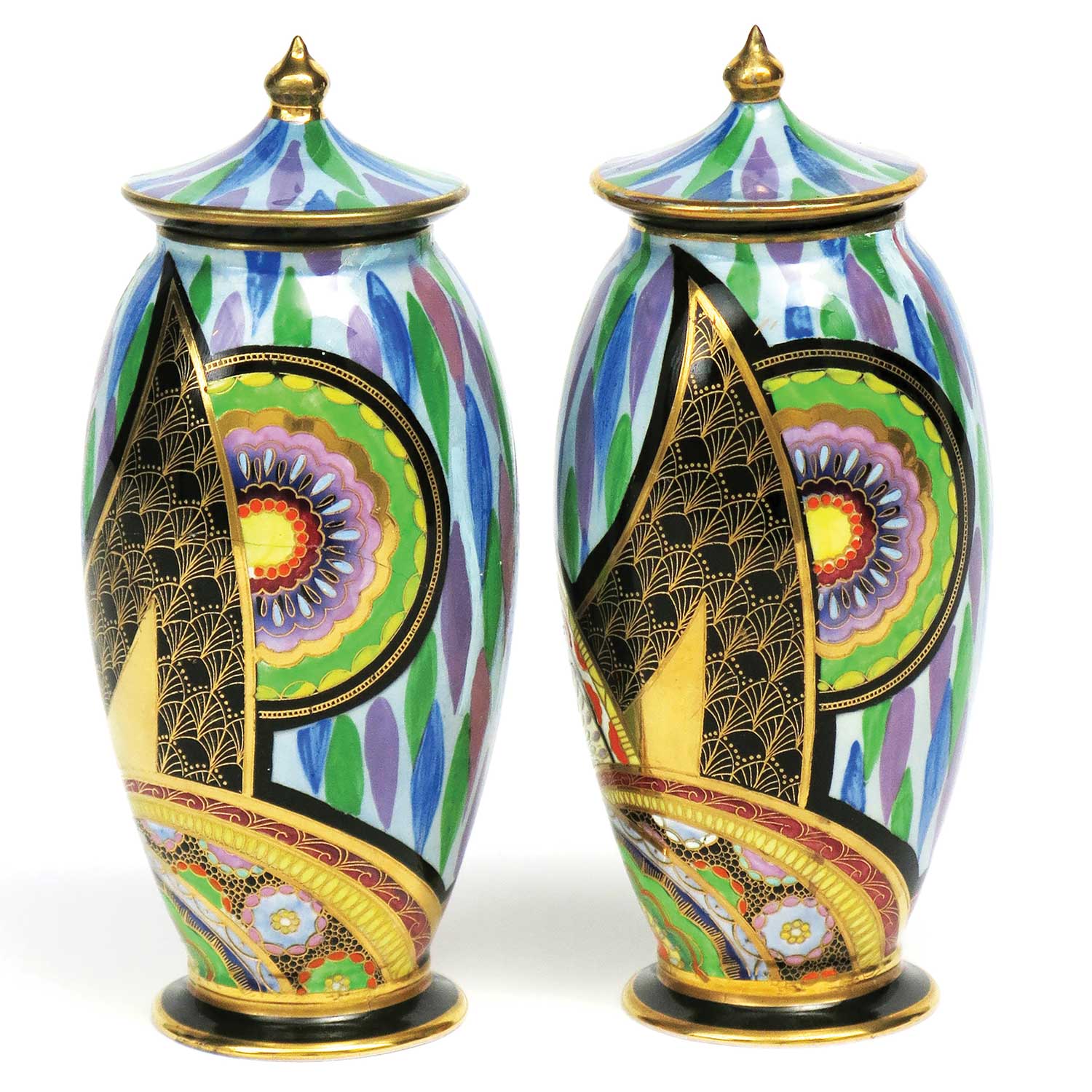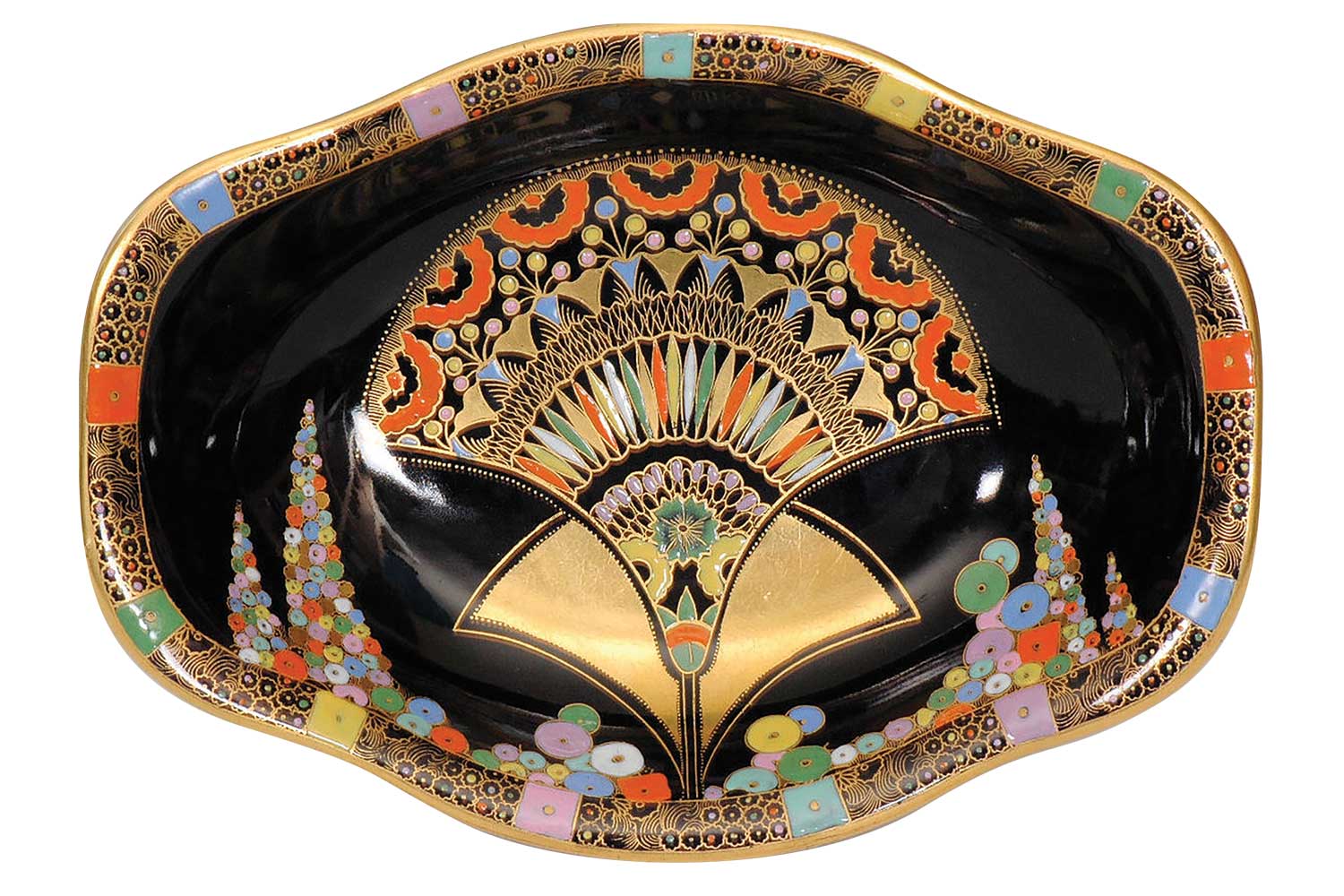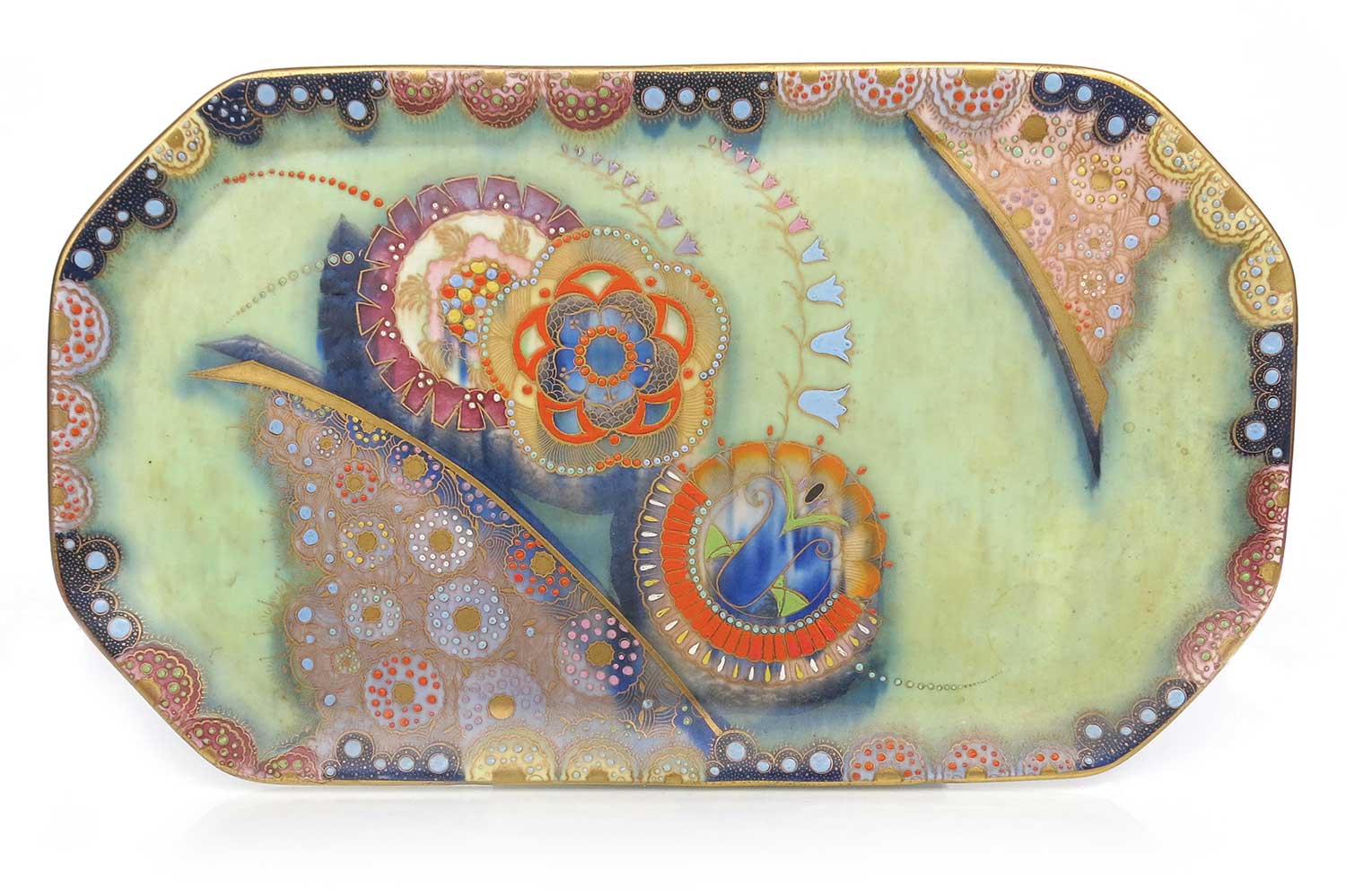

Back in 2012, a couple of English Carltonware collectors decided it was about time the world knew more about Violet. They’d been coming across some of her stunning Art Deco designs since the early 2000s but they’d been able to uncover precious little information about her or her work, so they decided to do what good collectors do best: research.
Elaine and Barry Girling began their quest for information in 2007. It took five years, but in 2012 they released a book: Cast Aside the Shadows. With only 100 copies published, today it’s almost as scarce as the information the Girlings sought.
They began at the end, with Violet’s death in 1988. She had no children, so there was no family line to trace, but an appeal for information via newspapers in Staffordshire (UK) turned up the details of Violet’s will. It contained the addresses of some of her relatives and the Girlings managed to contact an elderly cousin. As it happened, timing was everything: just two weeks after speaking to the couple the cousin passed away. “But he did fulfil a promise he made to us,” Barry told the East Anglian Daily Times in 2012, when being interviewed on the release of the book. “He was very cooperative and sent us a package of some of her [Violet’s] drawings and wedding photographs, and told us what he knew about her.”
Born in Oxford in the English spring of 1907, Violet was fortunate to have had a good art teacher at school and when she was in her late teens she entered a major art competition. Her work was given some national exposure, coming to the attention of Frederick Cuthbert Wiltshaw, who was managing director of Carlton Ware Pottery in Stoke-on-Trent. It’s thought that Wiltshaw was so impressed he wrote to Violet to offer to buy some of her paintings. Taken completely by surprise, the young artist couldn’t give a value to her work but subsequent discussions resulted in Wiltshaw offering her the position of designer at the factory, and in 1928 Violet moved to Stoke.
The Carlton Works in Copeland Street was a relatively small pottery compared with the likes of Wedgwood, Royal Doulton and Spode. “What it lacked in capacity it made up for in resourcefulness and adaptability,” write the Girlings. “The plant’s workforce was known to be happy, loyal and conscientious, it being not unusual for different generations of the same family to serve the company a lifetime. Violet Elmer would have enjoyed these pleasurable working conditions.” It’s quite possible that some of her earlier designs were part of the Carlton Ware exhibition at the British Industries Fair of 1930.

Frederick Cuthbert Wiltshaw, who engaged Violet as a designer in 1928, continued as Carlton Ware’s owner and Managing Director until his death in 1966, marking five generations of family ownership.
Violet also played an important role in the development of the Handcraft range, which was introduced in 1929 when the factory recognised the fashion for freehand painted decoration. The 1920s had seen an intense interest in highly glazed, expensive and brightly coloured lustre wares which Carlton Ware had adapted, using a cheaper firing technique that gave a similar result. When matt glazes became fashionable as a reaction to the highly glazed wares, Carlton Ware introduced softer, free-hand designs, mostly stylised floral but some geometric, with a matt glaze that gave a silky appearance.
From their research, the Girlings also believe the hugely popular embossed Buttercup design was Violet’s work. “The artwork was drawn from a close observation of nature,” said Barry, “and marketed about 1935. In all probability it was from the portfolio of Miss Elmer.” The ware was produced in a choice of either yellow or pink and included sugar-shakers, teapots, cheese dishes and salad bowls. The early embossed wares of the 1920s were the designs of Enoch Boulton, but in the 1930s a number were reimagined by Violet; her Crocus interpretation also included primroses, and was produced in a much larger range, typically on yellow or green backgrounds. “It was the success of the embossed wares that was instrumental in restoring the fortunes of the company,” Barry noted; the pottery had been placed into receivership in 1931 but by 1936 it was once again operating profitably.
But while the embossed ware was the company’s bread and butter, the line known as Best Ware was its creative pinnacle. Having built its reputation on its popular floral and fruit embossed products, in the late 1920s and ‘30s Carlton Ware explored the abstract, geometric and fantasy designs of the Art Deco era. They weren’t cheap to make; some of the output would have cost the average worker a large portion of their weekly wage.
Violet worked closely with senior designer Enoch Boulton, employing the geometric style that had its roots in the Aztec, Inca and Mayan cultures and stylising natural symbols such as shells and the sunrise. Sunbursts, zig-zags and lightning flashes were key components of many of the designs, along with fantasy birds, floral sprays and woodland scenes.
Made from 1929 – the year in which Violet succeeded Boulton as senior designer after Boulton moved to Crown Devon – until the late 1930s, the exotic and fantasy designs employed elaborate gold printed and enamelled patterns using highly skilled techniques that had been established with the earlier Blush Ware range. Best Ware patterns were often underglaze painted as well as using onglaze enamels and lustres, gold printing and raised enamelling. Carlton ware developed some of the most sophisticated techniques for lithographic transfer printing of any factory and applied a range of complex lustre finishes that often incorporated oxides and salts of precious metals. The factory employed a superb team of paintresses whose precise work on the overglaze enamels combined to produce a unique three-dimensional depth and many of the company’s employees spent their entire working lives here; Jess Bradshaw, who became Head Dipper and Shop Steward, worked at the firm for 55 years.
Violet’s dramatic, avant-garde work places her up there with today’s modernists. Many of her keynote designs – Floral Comets, Flower and Falling Leaf, Egyptian Fan, Fantasia, Bell, Devil’s Copse – would look as at home in a modern gallery as they did nearly 100 years ago and are still those that are most popular with Carlton Ware collectors today. In his 2014 book, Collecting Carlton Ware, author David Serpell describes Violet’s Bell pattern as ‘fantastically stylised and painted geometric flowerheads that cartwheel across space’ and says Scimitar has ‘jagged lightning and spiky, jostling leaves that grab attention’. He writes, ‘Echoes of the Egyptian discoveries achieve new expression in the elaborately hand enamelled pattern called Egyptian Fan.’ His praise for Violet’s designs is lavish although she is never mentioned and her name appears only twice, in the Price Guide for pieces at the back of the book.
Amazingly for such a range of output, Violet’s tenure at Carlton Ware was to last just a decade. She married woodwork teacher Arthur Lawton in 1938 and subsequently gave up her design work. She was succeeded by Irene Pemberton, who created the hugely successful patterns of Spider’s Web and Heron & Magical Tree.
The Girlings write that the remaining fifty years of Violet’s life seem rather uneventful when compared with the fruitful Carlton years. Although they had no children of their own, Violet and Arthur appear to have been a sociable pair and they organised firework displays, Christmas parties and similar events for nieces and nephews. They enjoyed rambling, and Violet was involved in charity work. She also loved her garden. Arthur died in the autumn of 1978. His widow lived another decade.
Following the publication of their book, the Girlings continued to promote Violet’s designs and between August 2016 and March 2018, some of her Best Ware pieces were on display at the Fitzwilliam Museum in Cambridge, which also holds one of the most important UK collections of European, Middle Eastern and Far Eastern ceramics. The pieces chosen for display were a Floral Comets charger, a Scimitar vase and a Bell vase. Said Elaine, “It is reassuring to know that such a prestigious museum recognises the contribution made to the Arts by those who were involved at the Carlton Works in the production of such exceptional ceramics.”